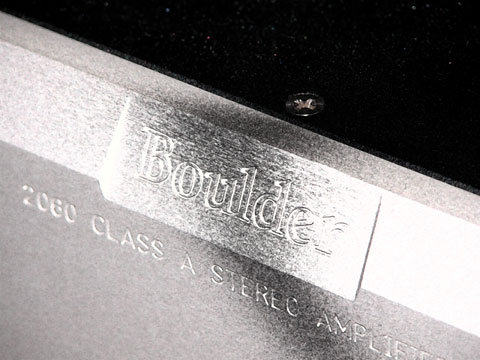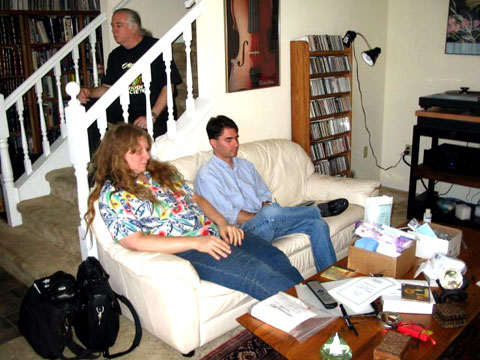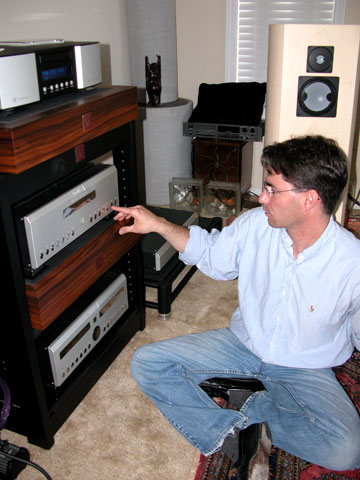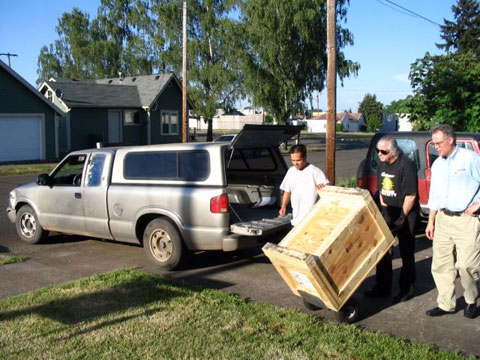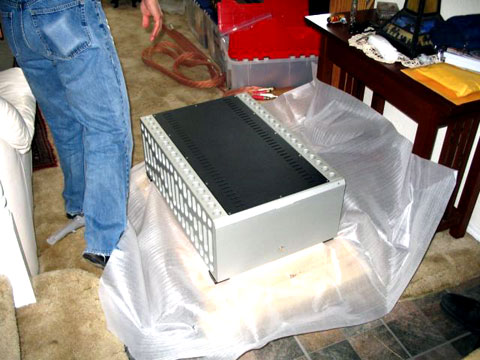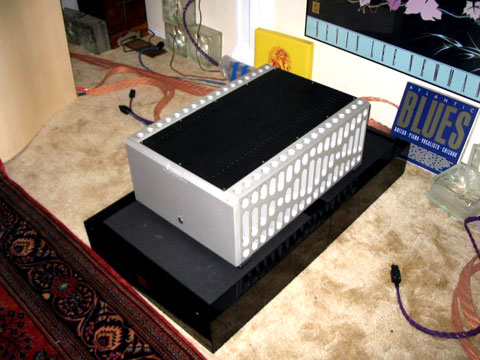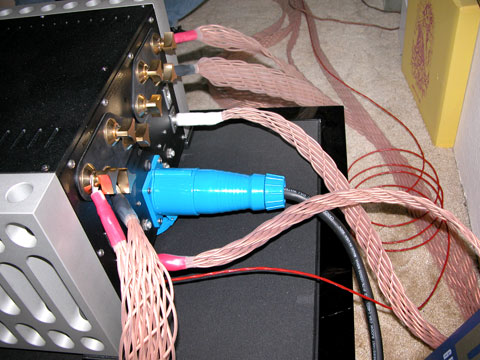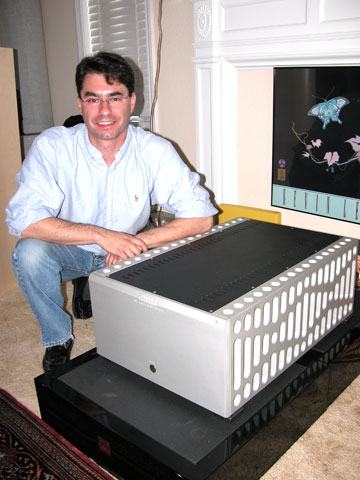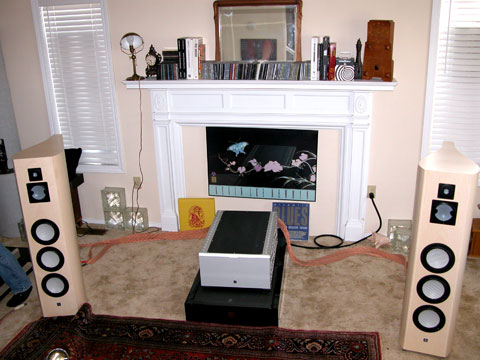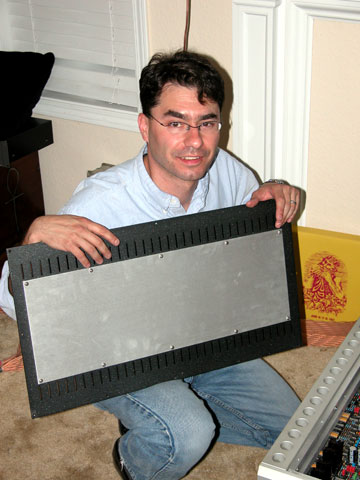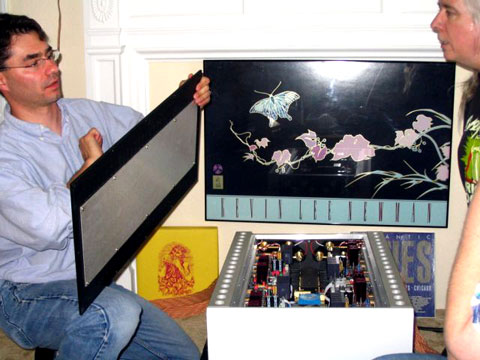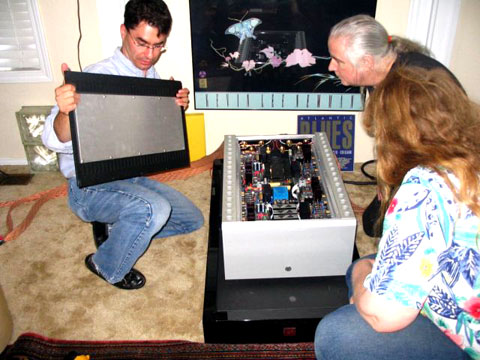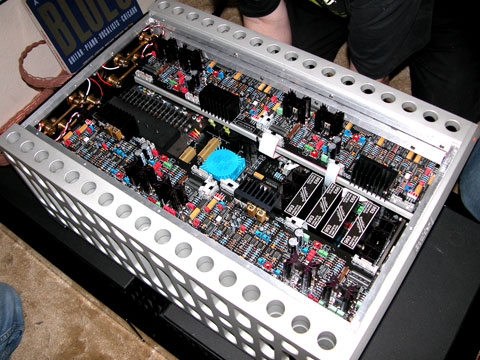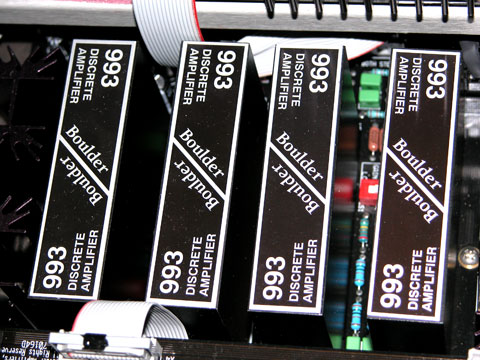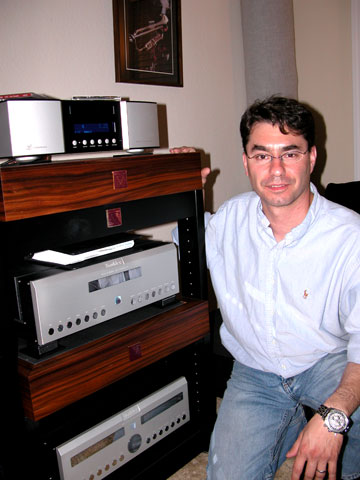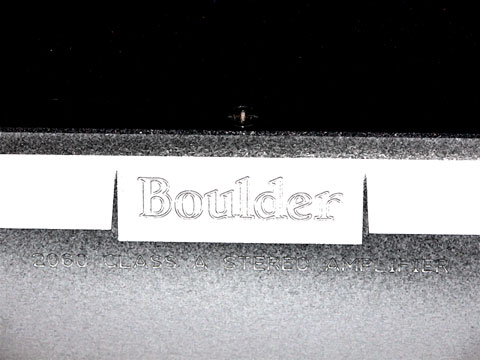|
You are reading the older HTML site
Positive Feedback
ISSUE
27
Dr. Sardonicus Meets the Invisible Man - The Boulder 2000 Series, Preamplifier, Digital - Analog Converter, and Stereo Amplifier [Photographs by Dr. S. and David W. Robinson; image processing by Robinson]
Introduction - Is it all about the Benjamins? I decided before I ever initiated this project ...if I were successful in getting the Boulder 2000 series in for review ...I would not engage in some silly rationalization about money. "I don't want to go off on a rant here ...but ..." Positive Feedback Online is largely about the machines used to reproduce recorded music. And it is a blessing there are many worthy machines out there, from a few hundred dollars to several hundred thousand dollars and pretty much every price point betwixt. In the past year I have auditioned active components retailing from about five hundred dollars, to over forty thousand dollars. Some I have liked and some I have not. Sometimes price needs to be discussed in a review; it even has to be considered when deciding if a review will actually take place ...and sometimes it is irrelevant. Most times, it is just one of many considerations given. The sub-500 dollar Dussun DS-99 integrated amplifier is all about price ...and that is a fact. (Check my comments on the Dussun integrated back in PFO Issue 24) Its performance-to-price-ratio is so off the hook as to demand that its price be highlighted in any consideration. The multi-chassis $350,000.00 WAVAC single-ended tube amplifier is also about price ...since it appears to hold the current record for retail on a production audio amplifier. How can you talk about a piece of audio equipment that costs just slightly less than TWICE the current median house price in the US, without mentioning that fact? In my world a barely competent forty-thousand dollar pair of speakers is going to be held up to that price point and ruthlessly examined, and frankly, it will be held to a commensurately higher standard relative to a less expensive product, which is only as it should be. For me, everything else simply falls somewhere into the continuum. Sometimes I think I see where the dollars go; other times I am acutely aware of pricing as a simple marketing strategy. And ...just as often ...I shake my head in wonder, just like the rest of you. Although I don't keep specific track, my memory is that I send roughly the same percentage of expensive and inexpensive things back. If it doesn't work and doesn't sound good, back it goes. So ...here is my one and only comment about Boulder and price ...the damned things are really expensive and it makes sense to me as to why they are. And that, as they say, is all I have to say about that! In the Beginning! I was delightedly surprised when Boulder (in the form of their new(ish) North America Director of Marketing, Rich Maez) offered to send me their entire 2000 series line of electronics (sans the phono stage, my table is really not up to it). After a relatively brief and very pleasant conversation and series of email exchanges Rich casually tells me he is sending me something in the neighborhood of $130,000 worth of Boulder electronics. I was born in Idaho; I know this expression, oh yes, Yee Hah! Waiting for Christmas to get here Both the Boulder preamplifier and DAC are multi-chassis affairs, and they were to be shipped in six separate boxes via normal means. The power amplifier is a single chassis, 240 pound behemoth, and it would be crated, pallet'ed, and shipped via truck. Rich would come personally to do the set up. Party on! Of course, this event called for the typical PFO audio set-up party, and all the usual suspects were invited to attend. There would be libations, snacks, mass quantities of Chinese food ...the usual sybaritic excesses. The way the process was set up, the preamplifier and DAC boxes were to arrive before the scheduled event, and the amp was scheduled for drop off the afternoon of the set up. I thought that this "just in time" approach spoke volumes about Rich's essentially sunny expectations about shipping companies, a philosophy I definitely do not share. My experience is that most shipping company's philosophy of business can be contained in two statements, "You'll get it when it gets there." And ... "This ain't Burger King® ...You can't have it your way." And Let There Be Light - Fun and Frivolity with High Fi - The PFO Way!
Jennifer Crock and Rich Maez sit on the couch and listen to Dr. S.'s room just prior to the changeover to the Boulder gear; Michael Crock does the same on the stairway. As is typical for these PFO events there was a trickle of arrivals until mid-afternoon on set-up day. There was food and drink and dancing girls ...well, all except that last part (Dancing girls having grown prohibitively expensive of late).
Boulder's Rich Maez dialing in the Boulder 2020 Advanced DAC (above) and the 2010 isolated balanced preamplifier (below). In person, Rich turns out to be this refreshing rarity in high end audio ...competent, flexible and without a discernable personality disorder; in other words, a passably normal and pleasant human being. Maybe it is because of the sheer number of audio butt-heads one must endure in being an active part of the audio community, or perhaps it is just that I am growing more appreciative of manners in my old age, but I am always delighted when someone representing a high-end manufacturer turns out to have both social skills and competency; Rich Maez is definitely one of those sorts. We all liked him immediately, and so the fun began. I knew Rich and I were going to be fast friends the minute I heard Nick Cave come up on his demonstration disc. No Barking Llama music for Rich. He is a music lover, as well as an audiophile. As is the PFO way, before installing the new equipment we listened to the current system, switching various things in and out. Rich was understandably impressed with differences wrought by the Jena Labs connects and power conditioning cables (which were new to him), but what stunned all of us was her new Esoteric 3D-X digital disc treatment. Upon hearing an A/B comparison between identical discs (one treated, one not), Rich just said, "Oh, that's just wrong!" (Meaning that the treatment alone could not possibly be making the difference he was hearing between the discs). From that point, we treated everything we listened to, and Rich went home with a supply, and an apparent addiction. Generally, digital powders and potions make my ass twitch, but this stuff has to be heard (and seen) to be believed. I am now unable to listen to a disc, or watch a DVD movie until it has been treated. This is so alien to me as to be unrecognizable. The Mountain Comes to... As we eagerly awaited the appointed hour when the lift-gate equipped truck would arrive with the massive Boulder 2060 power amplifier, we finally decided to tear down the current system and put the Boulder front-end in place.
The Boulder 2010 preamplifier. As he worked, Rich explained that Boulder customers are not typical audiophiles (the President of Hyundai motors is one of their customers, so I guess Rich is right) ...and they don't generally expect to be messing about with set-up, cables and other functional things. The average Boulder customer is richer than Croesus, and his/her expectation is that set up is done by the dealer. This is a good thing, because, between the Boulder-Link cable that lashes it all together, the relatively undifferentiated inputs and outputs and power leads (of which there are a copious supply), and the sheer number of boxes, the set up was neither straightforward nor intuitive. I didn't learn this until later 'cause Rich managed to make it look easy, all the while being an active part of the rapid PFO banter. Now we just needed an amplifier... And then it was later, and then it was much later, and then we called the shipper and whined, 'cause it was really late. "It should be there in minutes," we were assured. Yeah, I have the same confidence in shipping company dispatchers I do in North Korean political leaders. Most of them are half-crazed and NONE of them give a rat's patootie what effect their behavior has on others. The Little POS Truck that could (kinda) Finally, I heard a disturbance outside and some desultory sotto voce comment that, "The truck is here." Well, sarcasm is never in short supply with PFO'ers.
Yes, sports fans, believe it or not, this is how the Boulder 2060 was delivered! You won't have to imagine this because I have pictures, but here is this clapped out old import pickup, (truck, indeed) with its little bed filled to the brim with over three hundred pounds of boulder amplifier, stout wooden packing crate, and pallet. Someone had sent this poor clueless kid out into the hinterlands of rural Oregon with absolutely no ability to unload the thing had we not all been there to help. It cost more to ship the amplifier than the pickup was worth ...hell, they should have thrown it in with the deal! But I digress... We eventually managed to heave that huge thing out of the little truck, cart it into my listening room and uncrate it; dropping it on to two, Critical Mass stands (it was too heavy for a single stand).
Unwrapping the 2060 ...240 pounds of audio might!
The 2060 finally (!) at rest on a pair (front and back) of Critical Mass Systems amplifier stands.
Massive, massive: check out that main power cable (blue connector) in the midst of all that luscious JENA Labs cabling (copper woven). The Boulderlink control cable is the thin red cable. Now, the moment of truth was upon us. But How does it Look? Masters of Metal This is industrial art. It is not excess for the sake of excess ...it is not frippery and curlicues ...it is true industrial art; functional, meticulously executed and as clean and clear as the way mountain streams used to be. Simply elegant. This stuff is inarguably beautiful. This is the American Technical Craftsman at his or her best.
Rich Maez with the Boulder 2060 amplifier. Some days later I explained to a friend that he was looking at forty thousand dollars sitting there on the floor in the form of the Boulder 2060 amplifier ...he cocked his head back and forth and then said, "Yeah, I can see that."
The 2060 in place in Dr. S.'s listening room.
Rich Maez with the cover of the 2060, showing the damping layer underneath. It's rare to find chassis that are properly dampened from the factory. Rich pulled the top cover off the amp ...the chassis cover was fully damped with constrained layer materials ...and deader than a David Hasselhoff fan convention. Every millimeter of the huge chassis was brimming with beautiful things. Even as jaded as we are, we were impressed. There were lots of "oh's" and "ah's" to be heard.
Rich Maez demonstrates the dampening of the cover plate to Michael Crock.
Jennifer and Michael Crock checking out the interior of the 2060.
The interior of the Boulder 2060 stereo amplifier: loaded to the gills with performance and yummy craftsmanship. Rich shrugged and said basically the philosophy of Boulder is no compromises. How does a talented team of designers and fabricators work when no one is holding them to the dimes and nickels of typical production manufacturing budgets, where a fifty cent difference between two brands of the same part is the subject of yet another meeting? This is how. Build it and They Will Come He told the story of the 2008 phono stage, where a foreign distributor called the factory and asked them to design and build the most expensive phonostage in the world (it turned out to be circa $40K, but he didn't CARE how much it was), telling them he would send a cash order for ten units, sight unseen. They did. He did. Rich said they figured they might sell a handful a year, and instead it's several each month; the demand has been solid since introduction. They figure, build the best thing that can be built, and there will be people there to buy it. This is the Boulder philosophy and it has been very successful. In an industry that often has competitors fighting over scraps, Boulder continues to grow strongly and turn in record fiscal years. Interestingly, Rich also spoke with passion about "Made in America." Whatever we collectively may have come to believe about ourselves, Boulder's experience is that the rest of the world, and especially Asia, puts a premium price and high value on specialty American manufacturing, and it carries an earned cachet of excellence on quality and exclusivity.
Instead of trying to compete at the same level as manufacturers who are outsourcing and/or cheapening things, Boulder deliberately heads the opposite direction. Rich said their customers even take the tops off to see where the components come from, and do not expect to see Asian sourced parts. How ironic is that? Oh, I forgot ...the remote and the readouts ...yes, Virginia, it has readouts In one particularly memorable series of emails, Rich and I joked about what a Boulder phono cartridge would look like. We both agreed it would be machined out of solid ingot of aluminum and would require a counterweight the size of a Volkswagen. The 2000 series remote control weighs about two pounds, and strangely enough, it is machined from a solid chunk of aluminum. But this isn't the cool thing ...the cool thing is when you hit the power button, and the bulletin board readouts on the DAC and preamplifier scroll up to life, identify themselves and then display their operating modes ...all in letters tall enough to be seen across the most cavernous listening room ...and while they are doing this, they notify the monster power amplifier squatting there on the floor that it is time to awake, and the gently pulsating indicator light on the amp begins to blink. Count down. Power-up of the massive 2060 is gentle and takes some time ...no dimming lights, no sharp transients. Without the 'soft-start' the 2060's power requirements on start-up would probably take out the 20 amp breaker switch in most normal houses. I just know that this is what driving a turbo Bentley would be like. More Notes on the Set Up I have never met an audio manufacturer/distributor who was more indifferent about equipment set-up and optimization. Rich explained that their customers haven't the patience for such things, so enormous care is expended on mechanical and electrical isolation of each component, so as to make it as indifferent to its environment as possible. His attitude was pretty much, "Drop them down on a solid surface sufficient to the weight, and they will be fine." He did have some concern about AC supply in that the 2060 can draw up to 5000 watts in operation. He suggested that in a conventional home, the 1200 watt 2060 was more likely to experience AC sag, than it was to ever clip playing music. They actually warn you about fiddling with the speaker terminals when the amp is in operation. Whoeee. Talk about high powered amplifiers! As it turned out, there were two completely different set ups used in this initial review. In the first set up we put the two active front end components (preamplifier and DAC) on Critical Mass isolation filters in a Critical Mass stand, and put the two identical power supplies on some really cool Billy Baggs amp stands, off to the side (more later on the Baggs stands). The power amplifier, as stated before, went on two of the Critical Mass Grand Reference filters, placed directly on the carpeted floor. Everything was lashed together with the Boulder-Link umbilical. Only Jena Labs Pathfinder or better level cables were used throughout. After a few weeks, circumstances dictated a change in speakers, which dictated a change in the room, which dictated a complete change in the equipment set-up. Ultimately, the DAC and preamplifier went side-by-side on the Billy Baggs floor stands (with the power supplies neatly tucked underneath and my turntable and phonostage behind on Critical Mass suspension). Did I already say how cool those Billy Baggs stands are? We just spiked the power amplifier directly to the floor (the amplifier stands needed to go back to Critical Mass for updating). The Missing Link Ultimately, I found the BoulderLink annoying ...I wanted to be able to control each component separately and fighting the automated features of the link was like dealing with HAL before Dr. Chandra did therapy on him. So we lost the link in the second set-up. I now actually have to bend over and push the single, nickel-sized round turn on button for the power amplifier. Oh, woe is me. I have been dreading this next bit... Well, how does it sound? First, because of speaker issues of various kinds, it has taken a long time and lot of work to get a stable system that might, and I emphasize the word, might, give us the measure of the Boulder electronics. I even transferred the equipment over to David Robinson for a cross check (sadly, time pressures permitted him to only use the amplifier). I want to address the sound issue in two, somewhat separate initial "chunks". The first of these chunks is the 2010 preamplifier and 2060 power amplifier combo. I am not going to differentiate between them, because frankly they are cut from precisely the same cloth. I will talk about the DAC later. Functionally, I will just say there is literally nothing you might want or need to do, from lashing significant numbers of sources, matching volumes of inputs, labeling things your way, communicating between preamplifier and power amplifier, and driving any speaker in the world, etc., that might cause the Boulder 2010/2060 combination even the slightest hesitation. They cannot be shaken; they cannot be stirred. As unflappable as the Sphinx, they sit upon their vibration-damped feet like Sumo wrestlers magically transformed into prima ballerinas. Although it would probably take more time than I am going to be granted ...my strong suspicion is that other than this ineffably silky, effortlessness ...there is virtually no discernable sonic signature with these two pieces. Possessed of virtually unlimited reserves of power and bandwidth ...there are no compromises here. If neutral is the land you seek, its name is Boulder. On the Horns... So this is a helluva situation for a reviewer. I am supposed to write about what things sound like, and it appears that I am not capable of discerning any specific, identifying, sonic characteristic(s) with the Boulder amplification chain. I hear my other components ...I hear the recordings ...but I don't hear much (anything?) I can attribute to the Boulder gear. And this has been what others coming into my room have also observed. The most common comment about the Boulder equipment is ...neutrality. Actually, the most common comment is to sit down without comment and listen to music.
Boulder's Rich Maez with the Boulder front end (middle and bottom shelves); the Lindemann 820 SACD player is at the top. The Reviewer's Distress Deepens See, there are two schools of thought about Boulder I have heard iterated; the first is that of over-priced, over-built, sonic jewelry for the idle rich, and the other is the no-holds-barred reference equipment of choice for designers and builders of other electronic equipment and speakers. I was always curious, because it seemed such a polarized set of perceptions. Both could obviously not be simultaneously true. After living with the Boulder 2000 series in my listening room, I definitely fit into the second category. This is simply the most neutral, transparent amplification I have ever experienced. It is disconcertingly, disquietingly, NOT THERE. There are such enormous reserves of current and bandwidth that the stuff cannot even be forced into misbehavior to generate some kind of "sound". If it craps out, it's because the AC weenied, not because you actually challenged the equipment into clipping. Now this is a situation that will bring the artsy-fartsy bohemian reviewer to his senses in a most disturbing manner ...'cause if that reviewer has ever decried other people's feckless preference for "colored" equipment over neutrality ...gulp ...well, one faces a comeuppance of truly epic proportions, and not just because of finding something truly neutral, but the soul searching decision, is that neutrality really ..."best?" Ah, Screw It! I decided when I started writing again, that I would do so with élan ...I didn't care if I got myself into trouble, if I stepped on my own tongue, if I looked stupid from time-to-time, so long as I did the best and most honest and entertaining work of which I am capable ...even if that meant facing up to the fact that consistency (as Maude would say) is not really a human characteristic. So, personally protective equivocations aside, fed by what I think is the best single-box CD/SACD player in the world (the Lindemann 820; see my PFO reviews of same in Issue 24 at www.positive-feedback.com/Issue24/lindemann820.htm and www.positive-feedback.com/Issue24/lindemann_820.htm) through the incomparable Jena Labs interconnects and wires, and powering the triumphantly returned ESP Concert Grands (review to follow), the Boulder 2010 preamplifier and 2060 stereo power amplifier define high fidelity. No color, no grain, no texture of any kind, no compression, no chill, no warmth, no limitations, no compromises. Nothing heightened, nothing obscured ...this is not a straight wire with gain; this bloody stuff is stealth stereo; it just isn't there. Conclusion In the initial stages of the next review cycle to follow to the Boulder 2000 series, I am in the process of listening to a fully tube-driven system. This tube system is sweet, forgiving and very pleasant. It is not even particularly euphonic as tube electronics go, but the ruler dips at both ends of the frequency spectrum and even at 200 watts, (enormous output for a tube amplifier) it sounds dynamically and frequency-range compressed in comparison with the Boulder (but then, what wouldn’t?). What is fascinating to me is that this juxtaposition so clearly frames the very territory we audiophiles so often fight upon ...neutrality versus euphony. I will not allow myself to be passively herded into one camp or another at bayonet point. And oddly enough I find myself coming full circle to that which has defined most of my systems throughout my stint in high end audio. I like tubes at the small end and massive transistors at the big end. What I THINK ...is that the Boulder is the state of the art for accurate, neutral sound reproduction. I know of no other that bests it in this regard. What I FEEL ...is that with both the Boulder and the current all-tube system ...miss the carefully constructed middle ground of the BAT VK-51-SE and VK-600-SE (all of the virtues of both tube and solid state, with precious few of the downsides of purely either) and I will be glad when they are back in place. This being said, the Boulder 2000 Series is a remarkable accomplishment. It meets its stated design goals in a way few other pieces do. It is without discernable operational or sonic flaw or shortcoming and discernibly adds or removes nothing from the signal. It is neutrality incarnate. This is extraordinary, cost-no-object equipment defines the artisanal American industrial craftsman as well as anything I have ever experienced. Truly awe inspiring!
System Specifications1
Boulder 2010 Solid State Preamplifier Specifications
Gain stages are built entirely of discrete components. A total of eighteen 993 gain stages are used in the 2010. Balanced inputs use a true 3-stage instrumentation style design for lowest distortion and highest noise rejection possible. Outputs are fully buffered and balanced.
Boulder 2020 DA Converter (subject of a future review) Specifications
The 2020 D/A Converter features 993 stages. The three section chassis design (left audio, right audio, and digital) removes any interference between the analog and digital sections.
Boulder 2060 Stereo Power Amplifier Specifications
The Boulder 2060 has automatic load-sensing class "A" biasing provides ultra-low distortion at all listening levels. The fully balanced input circuit uses a pair of Boulder 993s to provide noise-free input buffering and most of the voltage gain. The output stage uses eighty (80) output transistors and forty-eight (48) power supply filter capacitors per chassis to assure stable, high current output into any load. Heat sinks are machined from solid aluminum, providing both optimum heat dissipation and higher instantaneous peak power without distortion. 1 Shamelessly lifted from manufacturer's specifications listing on website: http://www.boulderamp.com
Boulder Amplifiers Inc. (See the Boulder website for the email link.)
|

